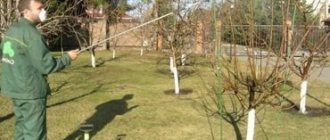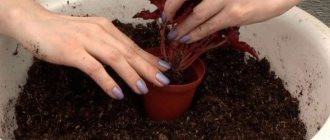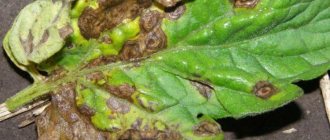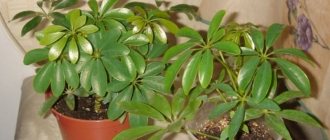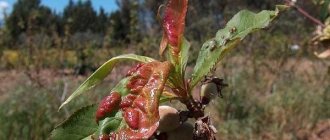Why does a garden fern turn yellow?
Garden ferns have won the love of gardeners not only due to their mystical aura: is it possible to keep indoor ferns at home? The plant fits perfectly into any environment. Garden ferns add a special charm to the area. Evergreen appearance, beautiful shoots, cool feeling. In order for the fern to always look beautiful, it needs to be properly cared for. In case of violations, modifications begin to appear, for example, the leaves (fronds) of the fern turn yellow.
Composition of soil for planting ferns:
- 1 part sand;
- 2 parts of garden soil;
- 2 parts peat;
How to fertilize ferns in the garden: organic matter and minerals
Before planting, the ingredients are processed and the hole is moistened. As you may have noticed, moisture must be maintained constantly, especially in the first months after planting on the site and during the transitional spring-summer periods.
Moisturizing ferns: watering and air humidity
Young ferns - the first 2 years after planting - are moistened regularly, monitoring the condition of the soil in the garden. It should dry out, but only a couple of centimeters, after which another batch of water is added again so as not to lose the root system. In summer, if the air temperature rises significantly, you need to mulch the soil mixture. Use herbs, sawdust, dry leaves, coniferous lapnyaks - any means that retains moisture, but does not allow rotting. We cannot change the air humidity in the garden, but additional spraying will return the green pigment to the leaves.
Yellow leaves of a garden fern with brown dots
If you notice brown dots on the lower leaves that look like pustules, then these are spores. Don't worry, the plant is not infected with pests - often mites on shrubs settle in such buds. Especially if it is time for the fern to reproduce, it will accumulate spores and then spread to new areas. Main features of the external structure of ferns . There is no need to pick, trim or otherwise remove the lower leaves with brown spots. The yellowing will disappear if care is restored.
↓ Write in the comments why your garden fern turned yellow and what did you do to revive it?
Please rate the material you read :)
What to do when indoor fern leaves dry
In order to grow ferns, it is necessary to provide proper care. If you purchased an indoor fern and the leaves of the plant dry out, then most likely the problem is insufficient watering. If measures are not taken, the plant may even die. To understand why this happens, you need to carefully study all the nuances of its breeding. Fern is a plant with a long history, popular among gardeners to this day. The reason lies not only in its beneficial properties, but also in its relative unpretentiousness and accessibility. There are more than 2,000 species with different leaf structures and colors that can be grown in pots.
More than 2,000 ferns can be grown indoors.
Fern diseases and pests
If the conditions for growing a house fern are not regularly observed, the plant is at serious risk.
- Watering with cold water with a large amount of chlorine leads to the appearance of an insect such as a nematode. As a result, the leaves turn yellow, dry out and disappear. The only salvation for the plant is to replant it, however, this measure may not help the fern. When replanting, it is necessary to treat the bush with an insecticide.
- Dry air causes scale insects, thrips and aphids to appear. Only frequent spraying of the fern will help avoid trouble. If insects appear, the bush is treated with an insecticide.
Home care
The main condition for breeding is sufficient watering, which in no case should be excessive. In order to grow a beautiful and healthy plant, you need to follow some breeding standards, which, however, are not too complicated.
It often grows in the wild, and this environment is the most comfortable for it: in the forest the plant does not suffer from diseases. The leaves of indoor fern often dry out, and this can happen even if the necessary rules are followed, and neither regular watering and fertilizers, nor replanting can save them, even though it is grown in “greenhouse” conditions. What is the cause of death and illness?
Most often, fern leaves dry out due to insufficient watering.
To prevent indoor fern from drying out, you need to care for it correctly. Usually it is an excellent indicator of the air in the apartment: an overdried or overly humid microclimate does not have the best effect on the health of the plant.
Based on its condition and appearance, one can judge the necessary rearrangements and changes in the room: for example, a gas leak or lack of moisture. In this case, you need to install a hood or air conditioner in the room, depending on the situation. This will save indoor ferns from diseases, and household members from negative influences from the outside.
Main reasons
Why does indoor fern dry out? This is a question you may well have asked yourself. There are several key reasons for the drying and wilting of a plant. All you need to do is consider them in detail and then make the right decision. If, for example, a Dutch indoor fern begins to disappear, it can be saved, but this must be done under the condition of comprehensive care. First of all, we will study why the tips of fern leaves dry out, and how to prevent it.
Watering errors
You will be able to quickly restore an indoor fern only if you can find out in time why it began to dry out in the first place. Most often, the plant suffers due to improper watering. Moreover, both waterlogging of the substrate and its drying out will not have the most favorable effect on the condition of the plant.
As a rule, if you over-water a fern, its lower fronds begin to actively turn yellow, and their tips simply dry out. In this case, the rhizome of the plant suffers the most - its shoots are constantly exposed to high humidity, so fungal formations or rot may appear on them. When there is a lack of water in the substrate, the flower looks drooping and lethargic, and it significantly slows down its growth. The leaves of this green specimen are turning yellow.
Most common diseases
If the fern leaves are covered with brown spots and the leaves have a wrinkled appearance, this means that the plant is suffering from insufficient watering and irregular spraying.
This threatens some varieties of fern with complete loss of leaves.
If this has already happened, the bush of the plant must be cut off, watered and sprayed regularly to resume the growth of new leaves. If they fade, it means the plant is suffering from excess sunlight, and in this case the fern needs to be moved to a cooler place. Lack of nutrients also negatively affects the health of fern leaves: they look thin and weak.
One of the reasons for leaf drying is parasites.
The leaves of indoor ferns can dry out due to pests, such as scale insects. Therefore, you need to constantly inspect the inside of the leaves. If brown spots appear on their surface, it means it’s time to take action. In order to save the plant from destruction, you need to regularly treat the leaves with a solution of Karbofos or Actellik.
Another reason why fern leaves dry out is insects and worms. To get rid of them, just run a swab soaked in alcohol over the surface of the plant and carefully remove the pests. If the plant is destroyed by aphids, this gradually leads to yellowing and falling of the leaves. If aphids are found, you need to treat the fern on all sides with a soap solution.
Diseases and pests of shrubs
If the conditions necessary for the plant are not met, it is endangered. When watering with cold water, nematodes may appear, which contribute to drying and yellowing of the leaves. To get rid of the parasite, it is necessary to treat the bush with an insecticide.
When the earthen clod dries out or the air is constantly dry, aphids, thrips or scale insects may appear. The bush must be treated with an insecticide and the bush must be sprayed regularly to avoid such troubles.
You might also be interested in watching a video about growing indoor ferns:
Health Conditions
To prevent diseases from overtaking the indoor fern, the plant requires proper care.
It is necessary to carefully choose a place for it: the fern needs sunlight, but an overly hot climate is detrimental to the plant. It is best to place it opposite a window, but so that the fern can get enough air.
Like any plant, ferns need care to maintain health.
It is also necessary to take into account that the fern usually reaches large sizes, and its leaves grow not only upward, but also in different directions. If the chosen location is insufficient, the plant will be cramped and its shape may become irregular over time.
The ideal soil for ferns is natural soil. The soil in the forest is loose, flavored with fallen tree leaves and bird droppings. Therefore, when caring for a fern at home, you should remember that the mixture for the plant should also have high acidity and, if possible, add ordinary soil taken from any garden plot.
It would be useful to add humus and sand there for looseness. Stagnation of water in a pot can cause the fern to rot and develop diseases, and the lack of moisture threatens it to dry out. Therefore, to prevent indoor fern from withering, you also need to monitor the condition of the soil.
Timely replanting of indoor fern should be carried out annually. After this period, the plant grows in breadth and height and therefore needs to change location.
It is best to replant indoor ferns in the spring, when the plants begin their growing season, otherwise the plant may weaken and the adaptation period will take much longer. The plant must be carefully placed there, having first prepared the soil for replanting. Naturally, the dimensions of the pot should be 3-4 cm larger than the previous one.
Ferns reproduce by dividing the bush, and this is best done during the spring replanting period, so as not to harm the plant. The division procedure is quite simple: you just need to separate the root rosettes at the base of the plant from the bush. After this, the embryos will need careful and careful care so that over time they can grow stronger and become an independent plant.
Fern leaves are the first to suffer from excessive or insufficient watering: they dry out or become stained. To avoid this, you need to water the plant regularly, but in this matter you need to observe moderation: as a rule, 3 times a week is quite enough.
In addition, you need to spray the plant regularly, although the frequency of procedures depends on the surrounding atmosphere. If the air in the room is dry, then you need to spray the plant daily; under normal conditions, this can be done twice a week.
If the plant is planted correctly, no additional feeding is required for the soil. She benefits from potassium, which is part of mineral fertilizers that can be found in any flower shop. The soil should be fertilized twice a month in spring or summer.
If you comply with all the necessary conditions for keeping a fern at home, then the plant will delight all household members with luxurious greenery for a very long time and will have a beneficial effect on the microclimate in the room.
What to do when indoor fern leaves dry
In order to grow ferns, it is necessary to provide proper care. If you purchased an indoor fern and the leaves of the plant dry out, then most likely the problem is insufficient watering. If measures are not taken, the plant may even die. To understand why this happens, you need to carefully study all the nuances of its breeding. Fern is a plant with a long history, popular among gardeners to this day. The reason lies not only in its beneficial properties, but also in its relative unpretentiousness and accessibility. There are more than 2,000 species with different leaf structures and colors that can be grown in pots.
More than 2,000 ferns can be grown indoors.
Home care
The main condition for breeding is sufficient watering, which in no case should be excessive. In order to grow a beautiful and healthy plant, you need to follow some breeding standards, which, however, are not too complicated.
It often grows in the wild, and this environment is the most comfortable for it: in the forest the plant does not suffer from diseases. The leaves of indoor fern often dry out, and this can happen even if the necessary rules are followed, and neither regular watering and fertilizers, nor replanting can save them, even though it is grown in “greenhouse” conditions. What is the cause of death and illness?
Most often, fern leaves dry out due to insufficient watering.
To prevent indoor fern from drying out, you need to care for it correctly. Usually it is an excellent indicator of the air in the apartment: an overdried or overly humid microclimate does not have the best effect on the health of the plant.
Based on its condition and appearance, one can judge the necessary rearrangements and changes in the room: for example, a gas leak or lack of moisture. In this case, you need to install a hood or air conditioner in the room, depending on the situation. This will save indoor ferns from diseases, and household members from negative influences from the outside.
Main diseases of ferns.
Infectious diseases of ferns caused by bacteria, fungi, and viruses are widespread. The most common forms of these diseases are:
- plaque on the surface of leaves, shoots (gray rot, etc.),
- leaf curling,
- rotting of roots and stems.
As measures to combat infectious diseases of ferns, it is recommended to remove and destroy the affected parts. Chemical plant protection products should be purchased only in special stores, not forgetting to take instructions for use. The liquid drug in the ampoule should be checked for transparency: if a sediment appears, most likely the effectiveness of the drug leaves much to be desired. The same can be said about expired drugs. If there are few pests, then you can sprinkle the plants with infusions and decoctions of onions, garlic, and white mustard.
Fern diseases with photos and descriptions.
Anthracnose fern
Signs: dark spots appear on the leaves of plants, dark brown streaks appear at the ends of the leaves.
Control measures: remove and burn affected leaves, treat the plant with a systemic fungicide, do not spray the leaves for a week and reduce watering as much as possible.
Root rot
Signs: the leaves turn yellow and then darken and the plant dies. The disease develops due to waterlogged soil.
Control measures: reduce watering.
Spotting on fern leaves
Signs: wet brown spots on the leaves; with severe damage, small spots increase in size and merge.
Control measures: remove affected leaves, burn them, spray the plant with a systemic fungicide. Do not water or spray the plant for several days.
Gray rot
Signs: gray fluffy mold on leaves, stems and soil. Gray rot fungus affects the entire plant.
Control measures: effective control of gray mold begins with preventive measures: do not place plants too closely together, often ventilate the premises when watering, avoid getting water on the leaves, as well as fertilizers with a high concentration of nitrogen. Too much nitrogen causes cell walls to become soft, making the tissue susceptible to infection. At the first signs of fern infection with gray mold, all affected parts should be immediately removed to reduce the possibility of the disease spreading to healthy plants. Acute infection can be treated with effectively applied special fungicides against gray mold.
Most common diseases
If the fern leaves are covered with brown spots and the leaves have a wrinkled appearance, this means that the plant is suffering from insufficient watering and irregular spraying.
This threatens some varieties of fern with complete loss of leaves.
If this has already happened, the bush of the plant must be cut off, watered and sprayed regularly to resume the growth of new leaves. If they fade, it means the plant is suffering from excess sunlight, and in this case the fern needs to be moved to a cooler place. Lack of nutrients also negatively affects the health of fern leaves: they look thin and weak.
One of the reasons for leaf drying is parasites.
The leaves of indoor ferns can dry out due to pests, such as scale insects. Therefore, you need to constantly inspect the inside of the leaves. If brown spots appear on their surface, it means it’s time to take action. In order to save the plant from destruction, you need to regularly treat the leaves with a solution of Karbofos or Actellik.
Another reason why fern leaves dry out is insects and worms. To get rid of them, just run a swab soaked in alcohol over the surface of the plant and carefully remove the pests. If the plant is destroyed by aphids, this gradually leads to yellowing and falling of the leaves. If aphids are found, you need to treat the fern on all sides with a soap solution.
Growing
This fast-growing perennial fern has survived since the age of the dinosaurs. Its homeland is the tropical zones of Australia, America, Southeast Asia and Africa. It is a real natural filter: nephrolepis absorbs and neutralizes vapors of toluene, xylene and formaldehyde, kills pathogenic bacteria . Caring for the plant is not difficult.
Soil and fertilizers
Choose porous and light soil. A universal substrate from the store, with perlite (14 volumes) and high-moor peat, is perfect. Or you can make your own mixture by mixing 2 parts universal soil, 5 tablespoons of charcoal and 3-4 handfuls of coco soil (based on coconut fibers).
After purchasing nephrolepis, it is better not to leave it in the old store-bought substrate. Give it a month to adapt to the new microclimate, and then replant it in new soil and a larger pot. Be sure to inspect the roots, remove rotten and damaged shoots. There is no need to bury the plant; leave the vertical rhizome above the soil level.
You can feed the plant from spring to late autumn - during these months nephrolepis actively develops. Fertilizer - mineral or organic - is applied every week .
In winter, it is enough to pamper the plant once a month, using organic and mineral compounds alternately.
But this applies to plants that overwinter in warm conditions. If during cold weather the indoor fern is placed in a cool place, it does not require feeding or care.
Adult, fully formed crops that have developed a root system are fed. Fern does not like large doses , so be sure to reduce the rate prescribed in the instructions by 4-5 times, and divide the monthly dose by the number of waterings.
Pot
A shallow pot is suitable for a young plant. Bulk containers will cause rotting of the root system. For a mature plant, choose a container that is larger but shallow - this will be more comfortable for its roots. The container must be stable and heavy, made of clay or porcelain. Be sure to disinfect it with a solution of potassium permanganate, vinegar essence or soda-salt solution. You can also use chlorhexidine, but this product is quite powerful and is more suitable for containers in which a plant affected by disease or pests has ever grown.
Don’t forget to put a 3-5 cm drainage layer on the bottom: river pebbles or small expanded clay.
Transfer
A healthy young (up to 3 years old) plant needs to be replanted every year in the spring. Cultures older than 3 years – once every three years. Of course, if the plant gets sick or its roots become crowded - as needed. Replant carefully, trying not to disturb the earthen lump on the roots . Large specimens can be divided into two and planted in separate containers.
Health Conditions
To prevent diseases from overtaking the indoor fern, the plant requires proper care.
It is necessary to carefully choose a place for it: the fern needs sunlight, but an overly hot climate is detrimental to the plant. It is best to place it opposite a window, but so that the fern can get enough air.
Like any plant, ferns need care to maintain health.
It is also necessary to take into account that the fern usually reaches large sizes, and its leaves grow not only upward, but also in different directions. If the chosen location is insufficient, the plant will be cramped and its shape may become irregular over time.
The ideal soil for ferns is natural soil. The soil in the forest is loose, flavored with fallen tree leaves and bird droppings. Therefore, when caring for a fern at home, you should remember that the mixture for the plant should also have high acidity and, if possible, add ordinary soil taken from any garden plot.
It would be useful to add humus and sand there for looseness. Stagnation of water in a pot can cause the fern to rot and develop diseases, and the lack of moisture threatens it to dry out. Therefore, to prevent indoor fern from withering, you also need to monitor the condition of the soil.
Timely replanting of indoor fern should be carried out annually. After this period, the plant grows in breadth and height and therefore needs to change location.
It is best to replant indoor ferns in the spring, when the plants begin their growing season, otherwise the plant may weaken and the adaptation period will take much longer. The plant must be carefully placed there, having first prepared the soil for replanting. Naturally, the dimensions of the pot should be 3-4 cm larger than the previous one.
Ferns reproduce by dividing the bush, and this is best done during the spring replanting period, so as not to harm the plant. The division procedure is quite simple: you just need to separate the root rosettes at the base of the plant from the bush. After this, the embryos will need careful and careful care so that over time they can grow stronger and become an independent plant.
Fern leaves are the first to suffer from excessive or insufficient watering: they dry out or become stained. To avoid this, you need to water the plant regularly, but in this matter you need to observe moderation: as a rule, 3 times a week is quite enough.
In addition, you need to spray the plant regularly, although the frequency of procedures depends on the surrounding atmosphere. If the air in the room is dry, then you need to spray the plant daily; under normal conditions, this can be done twice a week.
If the plant is planted correctly, no additional feeding is required for the soil. She benefits from potassium, which is part of mineral fertilizers that can be found in any flower shop. The soil should be fertilized twice a month in spring or summer.
If you comply with all the necessary conditions for keeping a fern at home, then the plant will delight all household members with luxurious greenery for a very long time and will have a beneficial effect on the microclimate in the room.
Caring for indoor ferns at home
Such an ancient plant as fern was grown back in the Victorian era. And now these openwork shrubs are very popular. They decorate apartments and houses, plant them in hotels, offices and other institutions. Almost all types of ferns survive various natural disasters well and survive in the most difficult conditions. Some ferns can be grown at home. In order for this plant to please you with its appearance, you need to know the basic rules for caring for ferns at home.
Description of the plant
All ferns are perennial epiphytic plants. What does this bush look like? Its appearance is the same. A beautiful rosette is formed above the underground rhizome, which is formed by curved lanceolate or entire leaves.
More than 10 thousand species of herbaceous, terrestrial, aquatic and tree ferns grow in nature. They can grow in meadows, swamps or forests. Among them there are giants and little ones, and the leaves reach a length of more than half a meter. The leaves of moisture-loving plants are strongly dissected and light green in color. Drought-resistant shrubs have leathery leaves, sometimes with a waxy coating.
Fern care
How to care for ferns at home? It is imperative to follow the rules for growing and caring for this plant.
Lighting and temperature conditions
When caring for this plant, it is necessary to provide it with good lighting, but so that it is not exposed to direct sunlight . According to many gardeners, ferns are shade-tolerant shrubs. However, in the shade such a plant stops growing and may die. To keep its leaves healthy and large, it requires diffused but bright light . It is advisable to place the pot with shrubs on a window facing the southeast side.
Indoor fern feels great indoors at an air temperature of 15 - 22 degrees . It should be noted that all varieties of fern prefer well-ventilated rooms and do not tolerate drafts and cold air at all . In the warm season, pots with shrubs should be placed on the balcony or in the garden, not allowing direct sunlight to fall on them.
Humidity and watering
Caring for ferns at home involves following a certain watering regime. Such a shrub should be watered regularly as soon as the top layer of soil dries slightly. The number of waterings depends on the temperature in the room. In hot weather, water the plant several times a week. If the soil is dry for a long time, this will negatively affect the fern.
You need to know that if a bush spends several days in a dry earthen mixture, then after watering it will not recover. But excessive amounts of moisture are also detrimental to the roots of the plant. That is why it should be planted in well-drained soil so that excess moisture begins to drain off immediately.
Shrubs should be watered with soft water at room temperature. It is best if it is:
- standing for several days;
- boiled.
House ferns prefer high air humidity. them every day . In hot weather or indoors with radiators turned on, shrubs must be sprayed several times a day or a special humidifier must be used. In addition, you should take a shower from time to time.
Feeding products
Sometimes, during active growth, a fern indoor plant does not receive nutrients in the required quantity, so its leaves first begin to turn pale, after which they turn yellow and dry out. Therefore, you should feed the shrubs once a week with special complex liquid fertilizers.
The plant needs rest, so it should be allowed such a period from late October to mid-February. If at this time the plant is in a cool room, then you need to stop feeding and reduce the amount of watering by half.
Transplanting a plant
Caring for ferns at home involves annual replanting of young plants. Adult specimens should be replanted after the pot is completely filled with roots.
How to replant an indoor fern? The complexity of this procedure lies in the fact that such shrubs react extremely painfully to transplantation from one pot to another and take a long time to recover. Therefore, transplantation must be carried out using the transshipment method , when the roots of the plant are not cleared of soil during the process. It is best to replant ferns in the spring. For it, you should select a wide and low flowerpot, and the soil acidity level should be 5.0 - 6.6 pH.
Fern soil is prepared by mixing:
- 1 part peat, humus and leaf soil;
- 1/5 part bone meal.
The new pot should be 5 cm larger than the previous one, and drainage should be poured onto its bottom, then moss should be laid and a substrate should be added. The shrub needs to be planted, and its roots should be covered with an earthen mixture so that there are no voids between them. Immediately after this procedure, the plant is watered abundantly and this continues to be done for another two weeks.
Replanting a house fern
The best time to transplant house ferns is spring. Flower growers say the small size of the flowerpot is the main reason for replanting. If the plant is young, then it must be replanted annually; the difficulty lies in the fact that the plant tolerates the procedure painfully and can recover from it over the course of several months.
In order to damage the plant as little as possible, they use not the classical method, but the transshipment method. The bush with all the soil is transferred into a pot of larger diameter.
There is no need to clear the soil from the fern roots. Roots that are too delicate and fragile cannot be carefully cleaned without damaging them. The only exception is replanting in case of plant disease, when it is necessary to identify damaged roots and trim them.
To grow ferns, shallow and wide flowerpots are used. As for the earthen mixture, you can choose a ready-made substrate in the store, the main thing is to take into account the acidity of the soil. The fern prefers acidic soil (acidity level from 5.0 to 6.6 pH).
If you prefer to make your own soil mixture, use this recipe:
- Leaf soil - one part;
- Humus - one part;
- Peat - one part;
- Bone meal – one fifth.
Fern propagation
In nature, shrubs reproduce by spores, but this process is very complex and painstaking. At home, ferns should be propagated by dividing the bush . In this case, young root rosettes must be separated from the adult plant. This should be done with extreme caution, otherwise the roots may be damaged. We need to try to save as much land as possible on them.
The divisions are planted in prepared small pots and placed in a warm room in a place that is well lit. In order for young plants to adapt well and take root, comfortable conditions must be created for them. The air must have high humidity, and the bushes must be watered abundantly. The absence of such conditions has a detrimental effect on the plant.
Reproduction
Along with questions about how and when to replant a fern, you should also deal with the problem of its propagation, which can be solved in several ways. Ornamental garden fern, planting and care of which are discussed in this section, can be propagated by separating root cuttings, as well as by budding and spores.
The first method is the simplest; it consists of digging up a specimen growing in the forest and then separating the root shoots. The second option is applicable only in the case of transplanting varieties of ferns in which small buds grow on the leaves. When propagating, they are separated from the leaf part and then germinated on moist moss.
In the case of spores, the latter are scraped off the fern leaf, after which they are well dried and scattered over the surface of the earthen substrate. Provided they are sprayed daily, they germinate after a month and produce shoots that can be planted in the ground the next season.
Possible problems during cultivation
If all the necessary conditions are created and proper care is taken, no problems should arise. But sometimes indoor shrubs can be affected by the following pests:
- Scale insects, thrips, aphids . They appear if the air in the room is too dry, so when caring for the plant it should be sprayed as often as possible. If these insects do appear, the bush should be treated with special chemicals.
- Nematodes . This pest attacks shrubs if they are watered with cold water containing a large amount of chlorine. The leaves of ferns begin to turn yellow and dry out. The plants need to be urgently transplanted into new soil, having previously treated them with insecticides.
{SOURCE}
Why spots and plaque appear on fern leaves, key pests and plant diseases
Also, if yellowing or other spots or plaque is detected on the fronds, it is worth inspecting the flower for pests and diseases. If they are detected, the necessary measures must be taken immediately. But it is important to understand that with proper planting and care, the risk of fern infection is very low.
House fern pests
The scale insect is considered a fairly popular fern pest. Unfortunately, the plant does not always signal externally that a parasite has sneaked up, and only after a certain period of time, when the infection has reached its peak, do the fronds begin to dry out and fall off. Another difficulty in finding scale insects is that they settle at the very base of the leaves and are often indistinguishable from plant spores. Affected leaves must be pruned along with the petiole. Scale insects are removed mechanically by scraping them off with a brush. The plant is finished with Actellik (15-20 drops / 1 liter of water).
Also, the reason why the house fern dries out can be a spider mite, which causes harm by sucking the juices from the plant and likes to make cobwebs on it. The leaves wither, turn yellow and fall.
If watering is improper, nematodes may develop in the roots. In this option, only replanting the flower with Actellik treatment will help.
If the room has too much air without water vapor, the fern can be attacked by aphids and whiteflies. In case of severe infection, spraying with Actellik, Malathion, Aktara and other drugs can help. Mealybugs also cause yellowing of foliage
Diseases of indoor fern
Low temperatures and excess watering usually provoke the development of fungal diseases, such as, for example, gray rot, sooty fungus, etc. When these diseases appear, it will be too late to look for information on how to treat indoor ferns. It is better to protect the diseased plant from healthy ones in time in order to avoid infection. The use of fungicides will most likely be ineffective.
The best fight in this case will be to prevent the occurrence of diseases - maintaining the required level of soil and air humidity, and favorable temperatures.
